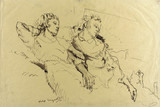Philip Howard Francis Dixon Evergood was an important socially concerned artist of the 1930s and 1940s and one of the few who painted in a strong, expressionist style. The son of a Jewish immigrant artist from Australia and a wealthy English mother, he was educated at Eton and Cambridge. His family name was changed from Blashki to Evergood in 1914.
In 1921 he began an extended period of study and travel in the United States and abroad, during which time he was a student at the Slade School in London, 1921-23, and in New York at the Art Students League with GEORGE LUKS and at the Educational Alliance School of Art. During his early years he also studied etching with Philip Reisman (born 1904) and Harry Sternberg (born 1904). In 1931 Evergood settled in New York and became friends with other artists concerned with social issues. He participated in the federal art projects and was appointed managing supervisor of the New York easel-painting division of the Works Progress Administration Federal Art Project in 1938. He joined the American Artists Congress and served as president of the Artists Union, 1937-38. Realizing the potential of the artist as propagandist and social innovator, Evergood during the 1930s established his reputation with social realist paintings that underscored the plight of the common man. His most controversial paintings of this period were American Tragedy, 1936 (private collection, New York), and the mural The Story of Richmond Hill, completed 1937, for a public library in Queens, New York.
His themes took on a more universal, humanist tone as political conditions changed in the late thirties and forties. While retaining the brilliant hues and expressionist black line of his early works, his style likewise was transformed, becoming increasingly fantastic, almost surreal at times. His socialist leanings led to his joining in 1938 those of like mind in the American Contemporary Artists Gallery (better known as A.C.A. Gallery), an association which lasted more than twenty years. Although he participated in the Whitney biennial and major annual exhibitions, he did not attract patronage until 1943, when Joseph Hirshhorn’s generous support enabled Evergood to devote his time solely to painting.
The importance of the graphic line can be seen not only in his paintings but in his prints, which he produced throughout his career.
BIBLIOGRAPHY
Archiv. Am. Art, Philip Evergood Papers; Oral History Collection, interviews with the artist, 1938-75 § Whitney Museum of American Art, New York, and others, Philip Evergood, exh. cat., 1960 (enl. ed., New York: Harry N. Abrams, 1975), with text by John I. H. Baur, bibliography and chronology by Rosalind Irvine § Lucy R. Lippard, The Graphic Work of Philip Evergood: Selected Drawings and Complete Prints (New York: Crown, 1966), with chronology, bibliography § Patricia Hills, "Philip Evergood’s ‘American Tragedy’: The Poetics of Ugliness, the Politics of Anger," Arts 54 (February 1980): 138-42 § Kendall Taylor, Philip Evergood: Never Separate from the Heart, A Center Gallery Publication (Lewisberg, Pa., and London: Bucknell University Press and Associated University Presses, 1986), with chronology, bibliography, lists of exhibitions and museum collections, checklist of exhibition held at Center Gallery, Bucknell University, and others, 1986-87.

